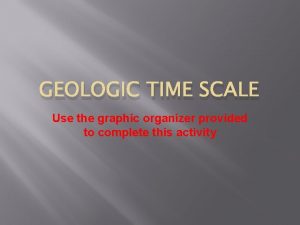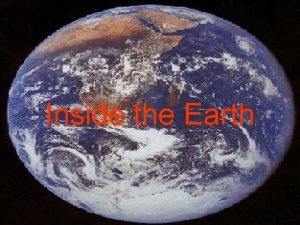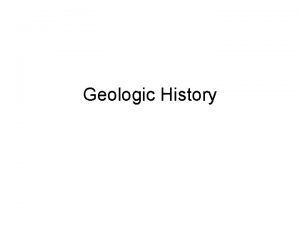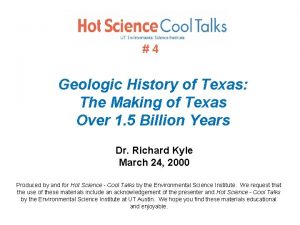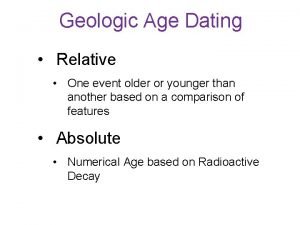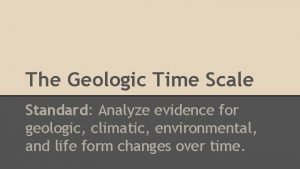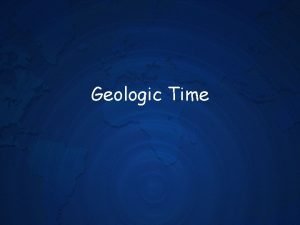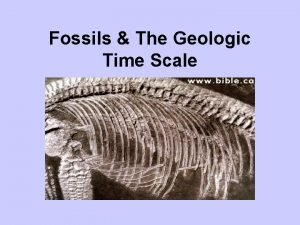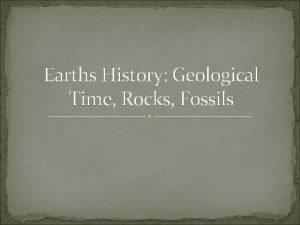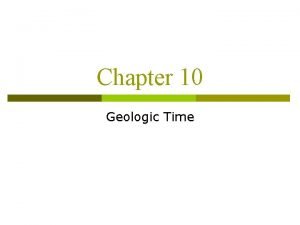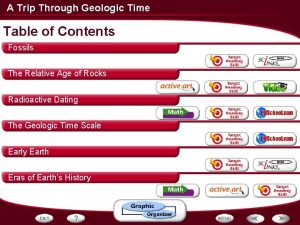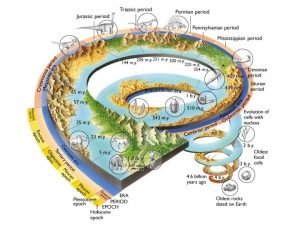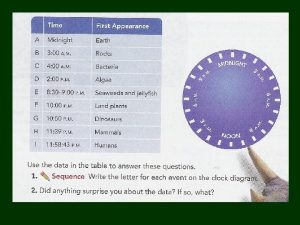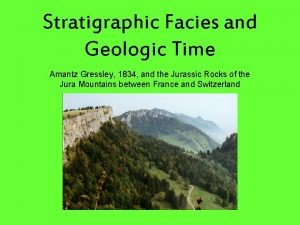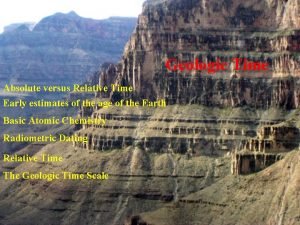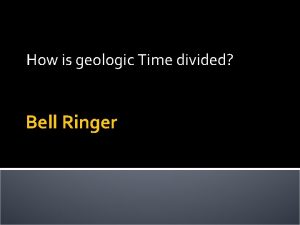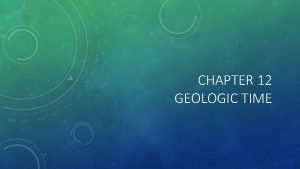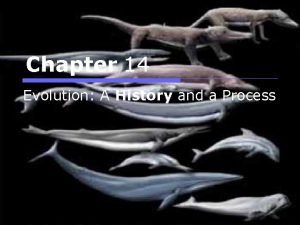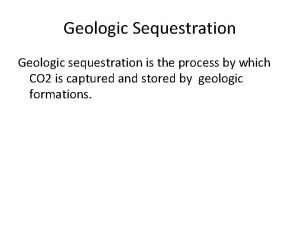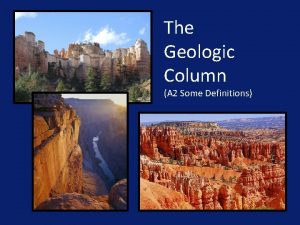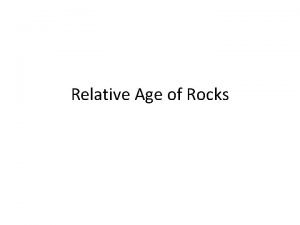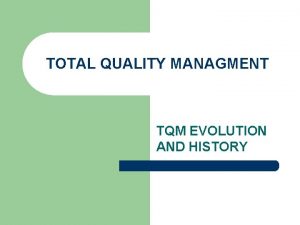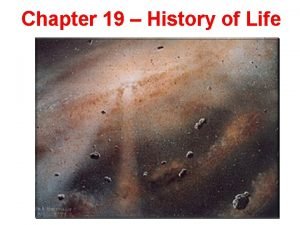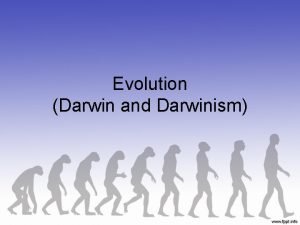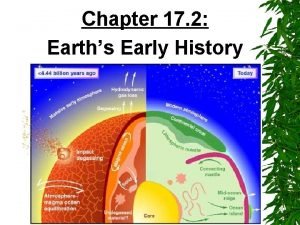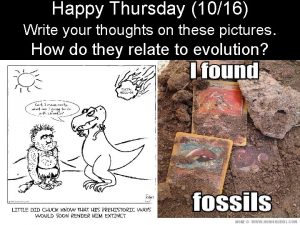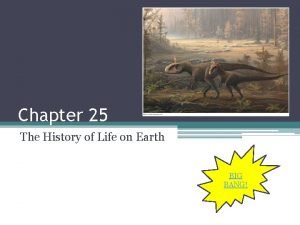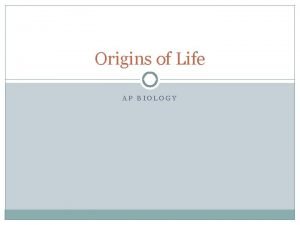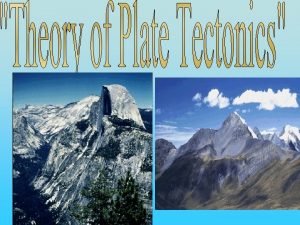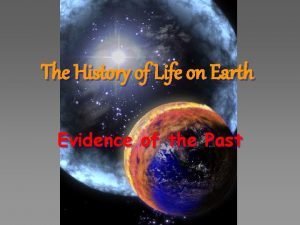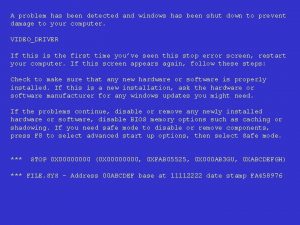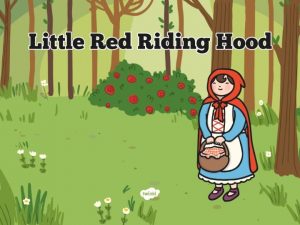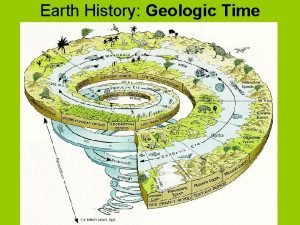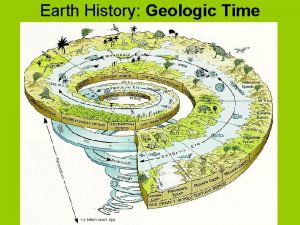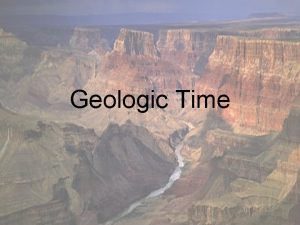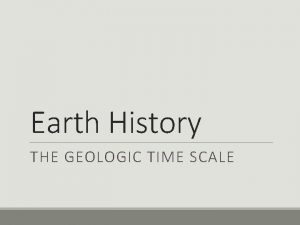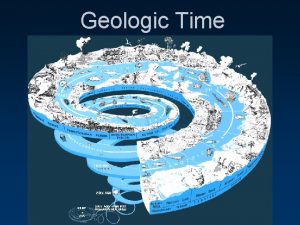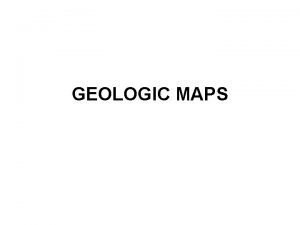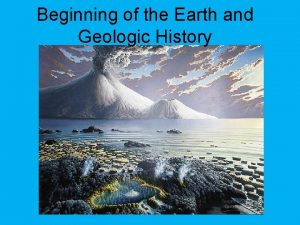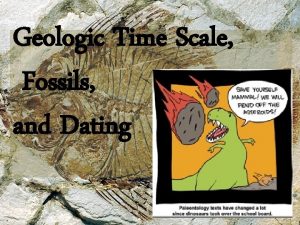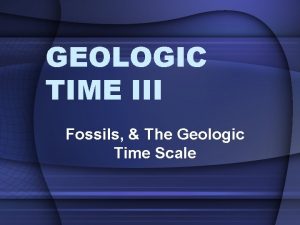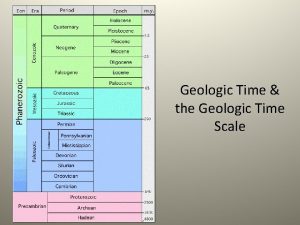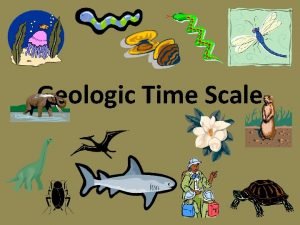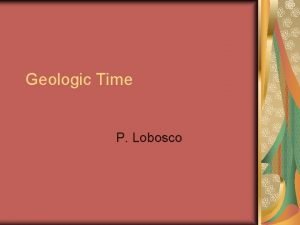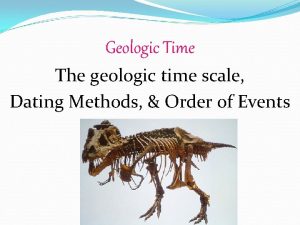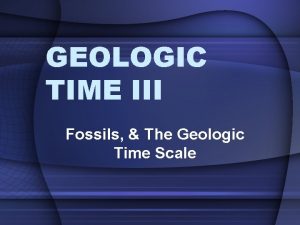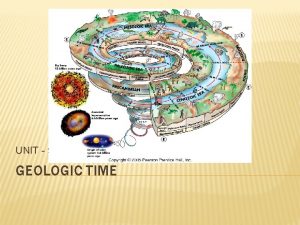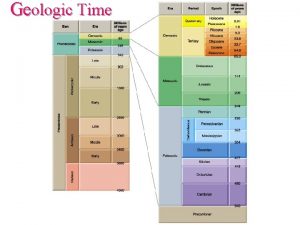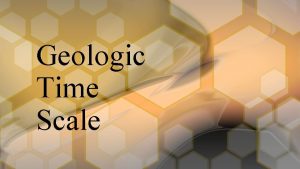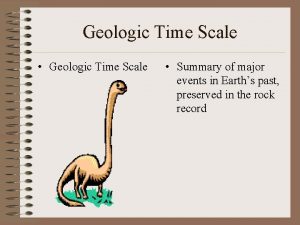Geologic Time and Evolution Earth Has a History




























































- Slides: 60

Geologic Time and Evolution

Earth Has a History • Geologic materials record enormous changes. • Earth is a complex, evolving system. – Physical and biological systems continuously interact. – Earth constantly changes and has done so through time. • • Species arise, flourish and disappear forever. Continents rift, drift and collide. Ocean basins open and close. Sea-level rises and falls.

The Hadean Eon • Earth was inhospitable; a molten surface. – Evidence of solidified igneous rock dates from 4. 4 billion years. • This evidence is from zircon grains, not a whole rock.

The Hadean Eon • Volcanic outgassing created a deadly atmosphere. – N 2, NH 3, CH 4, H 2 O, CO 2 and SO 42 - were components. – This atmosphere had a greater density that today’s. • Early formed crust was bombarded by meteorites. – Meteorite impacts were abundant between 4. 0 and 3. 9 billion years. • This would have destroyed early formed crust. • Oldest evidence of crust is 4. 03 billion years.

The Hadean Eon • The first oceans formed as rain from the skies. – Liquid water required cooling of the surface. – First evidence of oceans from marine sediments ~ 3. 85 Ga.

The Archean Eon • Time of significant change to planet Earth. • ~3. 8 billion years, Earth had cooled to form a crust. – Intense meteorite bombardment ceased. – Portions of the rock record begin to survive.

The Archean Eon • Life first appeared during the Archean. Evidence? – Biomarker molecules. – Isotopic signatures. – Preserved fossil cells. • Clear evidence of life in rocks dated to 3. 5 billion years. – Life may have started earlier. • Oldest undisputed bacteria fossils ~ 3. 2 billion years.

The Archean Eon • Rocks after 3. 2 Ga contain stromatolites. – Layered mats of cyanobacteria (blue-green algae). – Sediments stuck to mucous coatings on algal filaments. • Photosynthesis changed Earth’s atmosphere. – Converts CO 2 and H 2 O to organic matter and free oxygen.

The Proterozoic Eon • Protero = first; zoic = life. – Named before Archean life was discovered. • ~ 2 Ga (2. 5 to 0. 542 Ga); almost ½ of Earth history. • The unfamiliar Archean world changed to… – Fewer, larger lithospheric plates. – Larger continental landmasses. – An oxygenated atmosphere.

The Proterozoic Eon • Atmospheric O 2 permitted diversification of life. – Aerobic respiration more efficient; allowed multicellular life. • Without O 2, only single celled organisms possible. • Eukaryotic (nucleated) cells evolved by at least 1. 0 Ga. – The possibility of a land-dwelling biota. • O 2 made formation of the ozone layer possible. – Ozone absorbs deadly ultraviolet (UV) radiation. – Prior to the ozone layer, exposed land was bathed in UV.

The Proterozoic Eon • Over the last 500 Ma of the Proterozoic… – A gigantic leap in biological complexity. • Simple organisms gave way to complex ones. • Ediacaran fauna – Unusual softbodied fossils. – Preserved in end Proterozoic sediments. – Multicellular invertebrates resembling worms and jellyfish.

The Phanerozoic Eon • Phaneros = visible; zoic = life. • The most recent 542 Ma of Earth history. – Began with appearance of diverse hard-shelled organisms. • Hard-shells vastly increased fossil preservation. • Made possible a more complete archive of life on Earth.

The Phanerozoic Eon • The Phanerozoic is divided into 3 Eras. – Paleozoic – Ancient life. – Mesozoic – Middle life. – Cenozoic – Recent life. • Eras emphasize changes in Earth’s biota.

The Early Paleozoic • Cambrian and Ordovician Life Evolution: – Earliest Cambrian – Hard shells appeared for the 1 st time. – Massive diversification followed: the “Cambrian explosion. ” – Reflects the evolution of a complex ecosystem. • Plankton, deposit feeders, giant predators.

The Early Paleozoic • Cambrian and Ordovician Life Evolution: – Life during the Ordovician included several “firsts. ” • The 1 st vertebrates were jawless fish (agnathans). • The 1 st crinoids (flower-like echinoderms). • The 1 st green algae and primitive land plants. – The end of the Ordovician witnessed a mass extinction. – The seas roiled with life, but there was no life on land yet.

The Middle Paleozoic • Silurian and Devonian Life Evolution: – New species replaced those lost to extinction. – Vascular land plants evolved and spread across Earth. • Internal water transport systems. • Woody tissues. • Seeds. – Land plants changed Earth.

The Middle Paleozoic • Silurian and Devonian Life Evolution: – Fish rapidly evolve and proliferate. • Jawed fish. • Boney fish. – The 1 st land animals followed plants. • Scorpions. • Spiders. • Insects. • Crustaceans.

The Middle Paleozoic • Silurian and Devonian Life Evolution: – At the end Devonian, the 1 st amphibians appeared. • Walked on legs. • Breathed air with lungs.

The Late Paleozoic • Carboniferous and Permian Life Evolution: – Life continued to evolve. • Dense tropical wetlands hosted vegetation and giant insects. • Amphibians diversified. • Reptiles appeared for the 1 st time. – The amniote egg permitted reproduction away from water. – Reptiles populated previously inhospitable environments.

The Late Paleozoic • Carboniferous and Permian Life Evolution: – The Paleozoic ended with the Permian extinction. • 90% of all marine species disappeared. • Some evidence links the extinction to a bolide impact.

Early and Mid-Mesozoic Era • Triassic and Jurassic Life Evolution: – New species filled niches vacated by extinction. • Corals became dominant reef builders. • Gymnosperms proliferated. • Reptiles diversified. – Plesiosaurs – Swimming reptiles. – Pterosaurs – Flying reptiles. – Turtles appear.

Early and Mid-Mesozoic Era • Triassic and Jurassic Life Evolution: – By end of the Triassic the first true at dinosaurs appeared. – Dinosaurs differ from other reptiles in significant ways. • Legs are positioned beneath their bodies. • They bear evidence of warm bloodedness. – By the end Jurassic giant sauropods were abundant.

Early and Mid-Mesozoic Era • Triassic and Jurassic Life Evolution: – The 1 st feathered birds (archaeopteryx). – The 1 st ancestors of mammals appeared at Triassic. • They resembled small rat like creatures.

The Late Mesozoic • Cretaceous Life Evolution: – Teleost fish appeared and became dominant. • Symmetrical tails, specialized fins, short jaws, rounded scales. – Swimming reptiles and gigantic turtles swam the seas. – Angiosperms (flowering plants) appeared and spread. • Produce seeds rapidly. • Insects facilitate pollination. • Hardwood trees proliferated.

The Late Mesozoic • Cretaceous Life Evolution: – Dinosaurs reached their evolutionary peak. • • Inhabited almost all environments on earth. Social herds of grazing dinosaurs roamed the plains. Large carnivores fed upon the herbivores. Pterosaurs soared overhead, birds began to diversify. – Mammals developed larger brains and specialized teeth.

The Late Mesozoic • The K-T (Cretaceous– Tertiary) boundary event. – There is abundant evidence of catastrophic change. • Instantaneous global change in fossil assemblages. • Sudden mass extinction of most species on earth. – The dinosaurs which had ruled the planet for 150 Ma vanished. – 90 percent of plankton disappeared. – 75% of plant species vanished.

The Late Mesozoic • The K-T (Cretaceous–Tertiary) boundary event. – Catastrophic impact by a 10 km comet or meteorite. – The Chicxulub crater lies beneath the northern Yucatan. • Radiometric dating indicates the crater formed at ~ 65 million years. • 100 km wide; 16 km deep. • Periodic impacts are likely contributors to other extinctions.

The Cenozoic Era • Cenozoic (65 Ma-present) – The most recent history. • Cenozoic Paleogeography: – During the last 65 million years, Earth has continued to change. – The final stages of the breakup of Pangaea. • • Australia detached from Antarctica. Greenland separated from North America The North Sea formed between Britain and Europe. Sea-floor spreading continued to open the Atlantic Ocean.

The Cenozoic Era • Cenozoic Life Evolution: – After the K-T boundary, plant life recovered. – Forests of angiosperms and gymnosperms reappeared. – The 1 st grasses appeared in the middle Cenozoic. – Dinosaur descendants (birds) diversified and spread.

The Cenozoic Era • Cenozoic Life Evolution: – The Cenozoic is known as the age of mammals. – Mammals rapidly diversified to fill vacated niches. – By mid-Cenozoic huge mammals appeared. • Woolly mammoths. • Giant beavers. • Ground sloths. – Late Cenozoic, human ancestors 1 st appeared.

The Cenozoic Era • Cenozoic Life Evolution: – Ape-like primates diversified in the Miocene (~ 20 million years). – The 1 st human-like primate appeared about 4 million years. – The first members of the genus Homo appeared to 2. 4 million years.

The Cenozoic Era • Cenozoic Life Evolution: – What sparked the evolution of the genus Homo? • Climate changes that led to the spread of grasslands? – Permitted departure from the trees. – Life on the ground allowed more time for infant development. – This permitted growth of larger brains. – Homo erectus appeared ~ 1. 6 million years. • Made stone axes. – Homo sapiens appeared ~ 500 thousand years. – Modern humans appeared ~150 thousand years. – Many giant mammals died off 10 thousand years. • Climatic change? • Hunting pressure by humans?

The Geologic Time Scale

Pangea • Comes from Latin words – Pan = whole – Gaia = Mother Earth • Proposed by German scientist Alfred Wegener – Idea was based on: • • • “Fit” of the continents. Location of glaciations. Fossil evidence. Rock type and structural similarities. Paleoclimatic evidence.

Pangea

Glacial Evidence

Paleoclimatic Evidence

Fossil Evidence • Identical fossils found on widely separated land. – Mesosaurus – A freshwater reptile. – Glossopteris – Subpolar plant with heavy seeds. – Lystrosaurus – A nonswimming, landdwelling reptile. – Cynognathus – A nonswimming, landdwelling reptile.

Geologic Time • Discovering the magnitude of the Earth’s past was a momentous discovery in the history of humanity. • This discovery forever altered our perception of ourselves within nature and the Universe.

Geologic Time • Before the lat 17 th century, geologic time was thought to be the same as historical time – Believed Earth formed on October 23, 4004 BCE • Scientists began to find clues to an ancient Earth – Observed marine fossils high in the mountains • Ancient animals in loose sediment • Suggested long periods of time

Geologic Time • There are two ways of dating geological materials. – Relative ages – Based upon order of formation. • Qualitative method developed 100 s of years ago. • Permit determination of older vs. younger relationships. – Numerical ages – Actual number of years since an event. • Quantitative method developed recently. • Age is given a number.

Relative vs. Absolute • Relative ages assign order to events. • Numerical ages assign exact dates to events.

Relative Age • Uniformitarianism – The present is key to the past. – Physical processes that we observe today operated in the same way in the geological past. – Modern processes help us understand ancient events.

Relative Age • Superposition. – In an undeformed sequence of layered rocks… • Each bed is older than the one above and… • Younger than the one below. – Younger strata are on top; older strata below.

Relative Age • Horizontality and continuity. – Strata often form laterally extensive horizontal sheets. – Subsequent erosion dissects once-continuous layers. – Flat-lying rock layers are unlikely to have been disturbed.

Relative Age • Crosscutting relations – Geologic features intrude on preexisting strata • Igneous intrusions (dikes and sills) • Faults • Plutons


Relative Age • Inclusions – A rock fragment within another. – Igneous xenoliths – Country rock that fell into magma. – Weathering rubble – Debris from pre-existing rocks. • The inclusion is older than the material enclosing it.

Relative Age • Fossil (faunal) succession – Fossil remnants, or traces of once living organisms, are often preserved in sedimentary rocks. – Fossil are useful for relative age determination. • Several types of fossils will occur as an assemblage. • Fossils are time markers.

Fossil Succession • • Species evolve, exist for a time, and then go extinct. First appearance, range, and extinction dates rocks. Fossils succeed one another in a known order. A time period is recognized by its fossil content.

Fossil Succession • Fossil range – First and last appearance. – Each fossil has a unique range. – Overlapping ranges provide distinctive time markers. • Permit correlation of strata. – Locally. – Regionally. – Globally.

Fossil Succession • Evolution – Fossils preserve changes in Earth’s life. – Sedimentary rocks preserve fossil ecosystems. – Organisms inhabiting Earth have obviously changed. • Over geologic time, most species have exhibited both… – Trends toward specialization. – Catastrophic extinctions.

FOSSILS • Most common fossils are bones, shells, pollen grains, and seeds. • Only the hard parts of dead plants or animals become fossils. • The soft tissues either decay or are eaten before the fossils can form. 53

Fossils • Palentologist – A scientist who searches for clues to biological change by studying fossils • Fossils – They are used to form a picture of the Earth’s past – They are the remains or evidence of a living thing

FOSSILS • For fossils to form, the remains of organisms usually have to be buried in sediments soon after the organism dies. • Plants and animals that lived in or near water were preserved more often because sediment in the form of mud and sand could easily bury plants and animals that died in or along the sides of the water. • When sediments slowly hardened and changed to sedimentary rocks, the organism was trapped in the rocks. 55

Three Types of Rocks: • Sedimentary rocks are formed from layers of sediments. Most fossils are found here. • Igneous rocks are formed by cooling and hardening of hot molten rock or magma. • Metamorphic rocks are formed when sedimentary or igneous rocks are changed by heat, pressure, or chemical reactions. 56

Many Kinds of Fossils • Petrification: turning an organism into stone by replacing some or all of the animal or plant material with minerals. • Molds and Casts: There are two types of fossils formed when an animal or a plant is buried in sediments that harden into rock. 57

Many Kinds of Fossils • Molds: The empty space left in a rock when the soft parts of an organism decay and the hard parts are dissolved by chemicals. It has the same shape. • Casts: If the mold is filled in by minerals in the sediment it hardens to form a cast. It has the same shape. 58

Many Kinds of Fossils • Imprints: made by thin objects – such as leaves and feathers. They leave an impression in soft sediment like mud and then it hardens. • Trace fossils: Marks or evidence of animal activities such as, tracks, trails, footprints, and burrows 59

Many Kinds of Fossils • Preserving entire organism: 3 ways • Freezing: whole body or complete sections of organism is preserved. • Amber: Sap from trees hardens. If an insect is trapped in it, it is preserved. • Tar Pits: Animals become stuck in it and eventually sink, preserving the organism. 60
 Compare geologic time with the geologic column.
Compare geologic time with the geologic column. My geologic time scale graphic organizer
My geologic time scale graphic organizer Geologic layers of earth
Geologic layers of earth Original horizontality definition
Original horizontality definition Geologic history of texas
Geologic history of texas Geologic history
Geologic history Geologic history
Geologic history How is the geologic time scale organized
How is the geologic time scale organized Geologic time scale in a calendar year
Geologic time scale in a calendar year Geologic time scale animals
Geologic time scale animals Brainpop geologic time
Brainpop geologic time The longest subdivision of the geologic time scale is the
The longest subdivision of the geologic time scale is the Geological time scale graphic organizer
Geological time scale graphic organizer 4 divisions of geologic time
4 divisions of geologic time Moth scale
Moth scale Geologic time
Geologic time Time scale
Time scale Facies
Facies Geologic time scale poem
Geologic time scale poem Geologic time scale
Geologic time scale What is the longest subdivision in geologic time
What is the longest subdivision in geologic time 4 zoic eras
4 zoic eras Chapter 12 geologic time
Chapter 12 geologic time Start time end time and elapsed time
Start time end time and elapsed time History and evolution of repertory
History and evolution of repertory Future of facilities management
Future of facilities management Garde manger history
Garde manger history Kishore card repertory ppt
Kishore card repertory ppt Kent repertory published in which year
Kent repertory published in which year History and evolution of health information technology
History and evolution of health information technology Chapter 14 evolution a history and a process
Chapter 14 evolution a history and a process Caprock
Caprock Geologic column definition
Geologic column definition Geologic features
Geologic features California geologic energy management division
California geologic energy management division Faith reason and earth history
Faith reason and earth history Evolution of tqm
Evolution of tqm Clock analogy of earth's history
Clock analogy of earth's history Section 17-2 earth's early history
Section 17-2 earth's early history 17-2 earth's early history
17-2 earth's early history Clock analogy of earth's history
Clock analogy of earth's history Clock analogy of earth's history
Clock analogy of earth's history Section 17-2 earth's early history
Section 17-2 earth's early history History of the earth
History of the earth Discovery education
Discovery education Aerobic bacteria
Aerobic bacteria Rift valleys form when- *
Rift valleys form when- * Tuzo wilson
Tuzo wilson Composed upon westminster bridge figures of speech
Composed upon westminster bridge figures of speech Grander earth
Grander earth Problem has been detected and windows needs to shut down
Problem has been detected and windows needs to shut down Problem has been detected and windows
Problem has been detected and windows Every picture has a story and every story has a moment
Every picture has a story and every story has a moment Geographic terms jeopardy
Geographic terms jeopardy Once upon a time a little girl
Once upon a time a little girl Also history physical
Also history physical Setup time and hold time in digital electronics
Setup time and hold time in digital electronics How to find principal amount
How to find principal amount Calculating infusion time and completion time calculator
Calculating infusion time and completion time calculator Seek time hard disk
Seek time hard disk Work study diagram
Work study diagram

